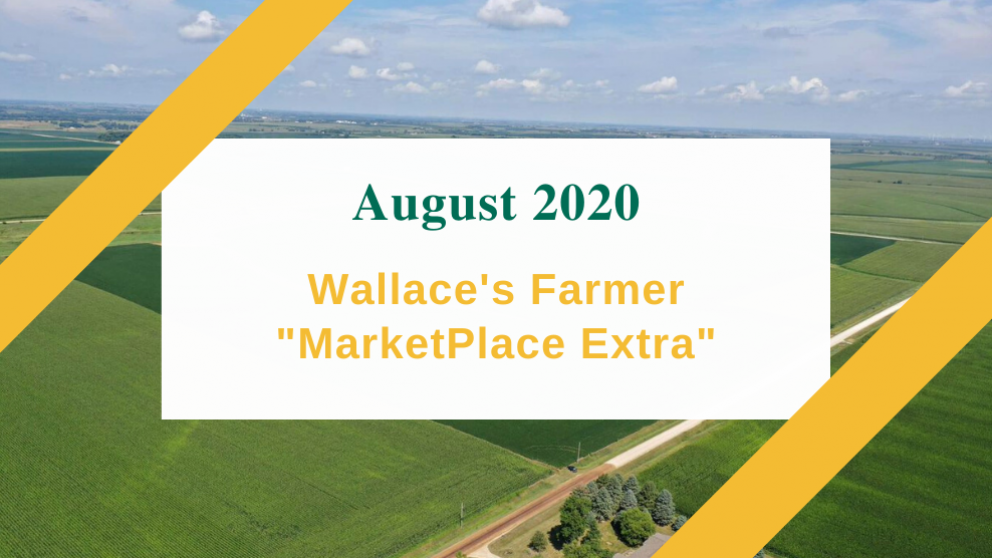August 2020 Wallace’s Farmer “MarketPlace Extra”

2020 has been a year unlike any other, with lots of surprises for everyone. For many in the investment world, this year has held more surprises than they would care to experience for the next couple decades! A surprise to some is the fact that farmland, as an asset class, has not really participated in the volatility drama that has played out this year in most other assets. Even in the face of the late spring/early summer commodity price slump, the horrible news coming from the ethanol sector, and widespread reports of breakdowns across the livestock sector, Iowa land values have seemingly kept their legs.
Without question, every year in agriculture is different. A strong (or poor) outcome in one year is not a guarantee for longer-term results, so there is always a reason to pull on your boots again the next day, the next month, or the next season. There is always a new challenge to overcome.
The farmland market has seemingly “shrugged its shoulders” – thus far – despite the havoc that COVID has caused. This has many market observers wondering why farmland is standing with such resilience, especially when other sectors of the investment markets are being legitimately whipsawed. I believe there are several macro-level factors that can help explain the stability the farmland markets have enjoyed across Iowa and the Midwest.
First, most farmland is owned with very little leverage, and this equity structure has created an incredibly firm foundation for the asset class. People who do not owe a payment on their farm do not worry as much about current conditions as those who do. Second, for those who have payments, low interest rates are supporting what leverage does exist in the sector. Third, there are very few farms for sale; quite simply the law of supply and demand explains the price support for the farms that are available. Fourth, government support towards agriculture, in the form of subsidized crop insurance premiums and outright emergency program payments, is extremely supportive to what is happening in the countryside. And finally, the strong long-term performance (and overall stability) of the farmland asset class is also a part of the answer. Said another way, people want to buy more farmland precisely because it tends to perform well in times when the wheels are coming off other investments.
At a more local/micro-level, the level of success of each growing season also influences the direction of our farmland market. This plays out neighborhood to neighborhood across the entire state. If one neighborhood has a huge crop compared to another, the area markets may perform slightly differently. That’s the market at work, and it happens that way every year, based on local results. The attitude across the countryside shifts up, down, or sideways, depending on whether neighbors all stuff the bins full or whether they are instead ‘looking forward to next year’. But as long as the macro-level factors described above remain stable, farmland should continue to avoid the violent swings of other investment alternatives. The sales noted below reflect that stable reality.
NORTHWEST
Clay County:
69 +/- acres, located northeast of Sioux Rapids, recently sold at public auction for $9,400 per acre. The farm consisted of 68 +/- tillable acres with a CSR2 of 94.7, and equaled $101/CSR2 point on the tillable acres.
NORTH CENTRAL
Mitchell County:
100 +/- acres, located near New Haven, recently sold for $5,500 per acre. The farm consisted of 98 +/- tillable acres with a CSR2 of 54.2, and equaled $103/CSR2 point on the tillable acres.
NORTHEAST
Bremer County:
155 +/- acres, located east of Frederika, recently sold for $9,392 per acre. The farm consisted of 152 +/- tillable acres with a CSR2 of 84.7, and equaled $113/CSR2 point on the tillable acres.
WEST CENTRAL
Guthrie County:
191 +/- acres, located southeast of Guthrie Center, recently sold via online auction for $7,030 per acre. The farm consisted of 171 +/- tillable acres with a CSR2 of 75.0, and equaled $105/CSR2 point on the tillable acres.
CENTRAL
Hardin County:
74 +/- acres, located east of Owasa, recently sold for $8,500 per acre. The farm consisted of 67 +/- tillable acres with a CSR2 of 86.7, and equaled $108/CSR2 point on the tillable acres.
EAST CENTRAL
Iowa County:
149 +/- acres, located southwest of Norway, recently sold for $6,711 per acre. The farm consisted of 139 +/- tillable acres with a CSR2 of 67.6, and equaled $106/CSR2 point on the tillable acres. Note: A tree-lined creek breaks the farm into two separate fields.
SOUTHWEST
Taylor County:
137 +/- acres, located southeast of Sharpsburg, recently sold at public auction for $4,350 per acre. The farm consisted of 137 +/- tillable acres with a CSR2 of 51.7, and equaled $95/CSR2 point on the tillable acres. Note: Approximately 47 acres of this farm are being cropped and approximately 90 acres are enrolled in CRP.
SOUTH CENTRAL
Decatur County:
210 +/- acres, located near Garden Grove, recently sold for $3,900 per acre. The farm consisted of 130 +/- cropped acres with a CSR2 of 41.1, while the balance of the farm featured grass waterways and timbered draws.
SOUTHEAST
Lee County:
95 +/- acres, located south of West Point, recently sold at public auction for $4,000 per acre. The farm consisted of 74 +/- tillable acres, with a CSR2 of 69.4, and equaled $74/CSR2 point on the tillable acres.
Hertz Real Estate Services compiled this list, but not all sales were handled by Hertz. Call Hertz at 515-382-1500/800-593-5263 or visit www.Hertz.ag.





